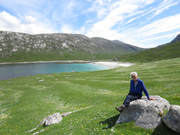 Six-spot Burnet Moth on Betony
Six-spot Burnet Moth on Betony Latterbarrow is special for the flora of limestone grassland with woodland fringes where fritillaries may appear. In July, agrimony and betony show well. There's angelica and Brian points out burnet saxifrage. And tells which moths favour golden rod as a food-plant. There has been overnight rain and fine grasses are drenched with raindrops. The morning is cloudy so few butterflies are on the wing but Chris knows the site well and tells how it's managed for butterflies and shows us micro-habitat favoured by particular species.




















 RSS Feed
RSS Feed